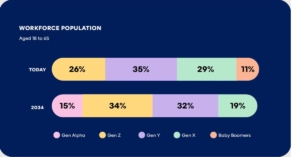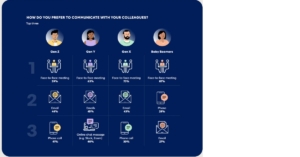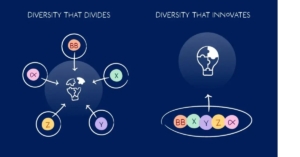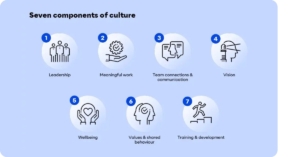Building Healthy Intergenerational Teams
By: Mark McCrindle
As the world of work rapidly evolves, forward-thinking leaders are turning their attention to one of the most powerful forces shaping organisational performance: the intergenerational workforce.
Today’s teams are more diverse in age than ever before, bringing together the experiences, expectations and energy of five generations. This mix presents both opportunities and complexities, particularly for leaders seeking to build resilient, future-ready organisations.
A Changing Workforce Landscape
The workforce is set to undergo significant changes over the next decade. Generation Z is on track to make up 34% of the Australian workforce by 2034, with Generation Alpha entering the workforce around the same time. In fact, by 2034, Generation Z and Alpha will comprise half of the workforce.
This demographic transition is not simply about age. It reflects deep changes in values, work expectations and communication styles. Older generations often bring stability, experience and a long-term perspective, while younger generations bring digital fluency, adaptability and a hunger for purpose. The key challenge for leaders is not viewing this diversity as a problem to be solved but a tension to be managed, alongside learning how to unlock it and use it as a strategic advantage.

With this change will come interesting intergenerational dynamics. Across the generations there are different approaches to the various aspects of work. When it comes to leadership, Baby Boomers respond to traditional, authoritative leaders who provide clear directives and demonstrate integrity. Gen X values autonomy, appreciating approachable leaders who offer guidance while promoting individual ownership. Generation Y, juggling competing priorities, seeks clear communication and work-life balance. Generation Z thrives under coaching or mentoring styles, valuing approachable and transparent leaders who support professional growth.

In terms of communication preferences, all generations prefer face-to-face meetings. The difference, however, is in the strength of this preference across the generations. Among Baby Boomers, almost nine in ten (87%) prefer face-to-face meetings compared to 59% of Gen Z. Younger generations, however, are more likely to prefer online chat messages with 40% of Gen Y, and 35% of Gen Z preferring this method, compared to 26% of Gen X and 11% of Baby Boomers.
Harnessing The Power of Diversity
Diversity, when not intentionally harnessed, can become a source of division, particularly when people are approaching problems from different angles without shared understanding. But when teams are aligned around a common purpose and facing the same challenge side by side, the true power of generational and cognitive diversity is unlocked. In this posture, differences in perspective become strengths rather than stumbling blocks. Leaders who create clarity around the “why” and foster mutual respect across age groups enable their teams to collaborate more effectively, think more creatively and solve problems more holistically. It’s not about everyone thinking the same, it’s about everyone thinking together.

Work As A Means To Create A Life You Want
Beyond earning an income, work is often used as a tool for individuals to craft a life tailored to personal purpose and fulfilment. Almost four in five workers (78%) believe their work serves as a means for crafting the life they want, rather than believing work is an opportunity to use their expertise to positively impact the world (22%).
Gen Z (80%) and Gen Y (80%) are slightly more likely to believe work serves to craft the life they want than Gen X (76%) and Baby Boomers (73%), who are slightly more focused on impacts.
Gen Z Are Looking For Regular Feedback
All generations thrive at work when they receive regular and constructive feedback. Yet, there are differences in how communication is best received by each generation. More than half of Gen Z (54%) would prefer praise at least a couple of times a week compared to 28% of Gen X. While this amount of praise may sound like a lot, Gen Z are looking for constructive feedback in equal measure.
With more generations contributing to the workforce, working in a cohesive generational team will be paramount for success. Given Gen Zs preference for frequent feedback, it is unsurprising that Gen Z are 1.5 times more likely to see feedback delivery (35% compared to 24% Gen X) and 1.4 times more likely to see feedback frequency as challenges of an intergenerational team (26% compared to 19% Gen X).
Alongside feedback from their leaders, Gen Z prioritise a safe space to share ideas (48%) and collaboration (48%) more so than their older counterparts. Generation Z thrives under coaching or mentoring styles, valuing approachable and transparent leaders who support professional growth. Ultimately they’re looking for leaders who value them and create a fun working environment. Fun in the workplace may seem like a nice-to-have but is increasingly becoming a non-negotiable. It is not enough to just have a compelling vision, accessibility and strong remuneration, people want to enjoy coming to work to bring about lasting impacts.
Generational Intelligence: A Strategic Leadership Capability
To lead effectively across generations, leaders need to develop generational intelligence – that is, the ability to understand, value and respond to generational differences in the workplace. This goes beyond flexible policies or communication adjustments. It is about creating a culture where everyone, regardless of age, feels respected, heard and able to contribute meaningfully.
For example, Baby Boomers tend to respond to leadership grounded in integrity and experience. Generation X often values autonomy and trust. Gen Y seeks balance, feedback and authenticity, while Gen Z craves transparency, mentorship and personal development. Leadership sets the tone for any organisation. Therefore, leaders who recognise and adapt to these preferences can unlock higher engagement and performance across the board.
Measuring and Improving Cultural Health
It is culture, not goals, that sets teams apart and, therefore, needs to be on the radar of leaders. Culture is the personality and values of an organisation that dictate how things are done and determines the overall organisational health. Culture is integral to achieving organisational goals and attracting and retaining talent of all generations.
Recognising the integral role culture plays for organisation health, McCrindle developed the Cultural Health Index (CHI), a cultural analysis framework comprising seven domains, to help leaders create thriving workplace communities with culture at the centre.
By collecting team-wide insights and benchmarking them against national norms, leaders can gain a clearer picture of where cultural strengths and gaps exist. Insight into these domains, particularly from a generational perspective, can help shape engagement and retention strategies that hit the mark. If leaders are not investing in culture for the health of the organisation today, then they must invest in it for the future of the organisation and its ability to attract talent from emerging generations.

Culture As The Anchor For Retention
Culture is no longer a soft metric. It is a strategic asset, and in many cases, a competitive advantage. A strong workplace culture is one of the most effective retention strategies an organisation can have. When people feel connected to their team, valued by their leaders and aligned with the organisation’s purpose, they are far less likely to seek opportunities elsewhere. This stability is not only good for morale, it is good for business. High retention reduces recruitment and onboarding costs, preserves institutional knowledge and builds momentum toward long-term goals. A flourishing, cohesive team creates a sense of continuity and confidence that drives performance. In a competitive talent market, culture is no longer just an HR initiative, it is a leadership imperative.
McCrindle’s Cultural Health Index found that the strength of cultural health is positively correlated with retention. More than three quarters of workers (77%) at organisations with excellent cultural health (score of 90+) intend to remain with their organisation for the next 12 months. Comparatively, 66% of workers at organisations with poor cultural health (<10) intend to look for a new job in the next 12 months. The tipping point occurs around organisations with low cultural health, where workers are almost equally likely to look for a new role as they are to stay.
Practical Strategies For Leaders
To build high-performing, intergenerational teams, consider these strategic approaches:
- Develop Generational Intelligence across leadership teams
Provide executive and middle managers with training and tools to better understand generational motivators, behaviours and communication styles. Make this a core leadership capability. - Use data to inform culture strategy
Employ tools like the Cultural Health Index to gain real-time feedback from employees. Use these insights to guide investment in leadership, communication and employee experience programs. - Establish cross-generational mentoring
Pair emerging leaders with experienced professionals to facilitate knowledge transfer and build mutual respect. This supports succession planning for the intergenerational knowledge transfer while fostering collaboration. - Invest in multi-channel communication
Different generations prefer different communication styles. Provide a mix of in-person briefings, digital platforms and collaborative tools to ensure key messages are consistently understood. - Promote shared purpose across the organisation
Unite teams through a strong organisational purpose that resonates across generations. Reinforce how each role contributes to larger outcomes, particularly those that create positive social change. - Create tailored growth pathways
Offer diverse development options that cater to different career stages and aspirations. Younger employees often seek clear progression and feedback, while older employees may value mentoring or legacy-building opportunities. - Celebrate generational strengths
Design recognition programs that acknowledge a wide range of contributions, from digital innovation to long-term service and mentoring. Reinforcing the value of all contributions builds cohesion and respect.
Leading for The Future
In a world where the pace of change is accelerating, building culturally healthy, intergenerational teams is no longer optional, it is essential. The future belongs to organisations that can blend experience with innovation, tradition with transformation, and structure with agility.
Leaders who invest in understanding and responding to generational dynamics will be better positioned to drive engagement, attract top talent and build adaptable, high-performing cultures. Tomorrow’s teams will not be built by accident. They will be shaped by leaders who are curious, courageous and committed to creating workplaces where every generation thrives.
Article supplied with thanks to McCrindle.
About the Author: McCrindle are a team of researchers and communications specialists who discover insights, and tell the story of Australians – what we do, and who we are.
Feature image: Canva




